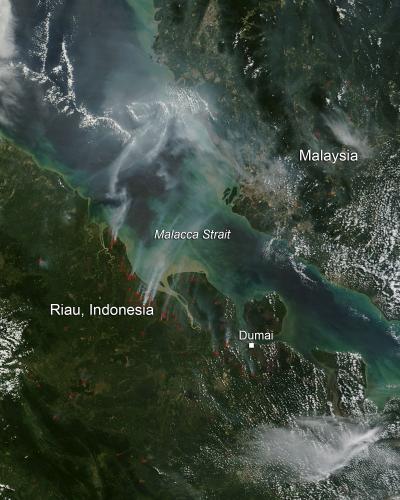Fires in Indonesia, July 2014

Terra and Aqua satellites detected 154 hotspots in areas across Riau province on Sunday, July 20, indicating forest and land fires had increased again following a decline in rainfall. The number of detected hotspots in Sunday's report was far higher than what had been reported one day prior, which had reached only 75 spots. Credit: NASA image courtesy Jeff Schmaltz, MODIS Rapid Response Team. Caption: NASA/Goddard, Lynn Jenner
The number of detected hotspots in Sunday's report was far higher than what had been reported one day prior, which had reached only 75 spots.
The hotspots were scattered in six regencies and municipalities, most of which were in northern Riau coastal areas. Smoke and the related haze it creates could potentially spread via winds to Malaysia and Singapore as it seems to be doing in this image.
The smoke released by any type of fire is a mixture of particles and chemicals produced by incomplete burning of carbon-containing materials.
All smoke contains carbon monoxide, carbon dioxide and particulate matter (PM or soot). The type and amount of particles and chemicals in smoke varies depending on what is burning, how much oxygen is available, and the burn temperature.
Smoke degrades air quality and precautions should be taken when around it.
This natural-color satellite image was collected by the Moderate Resolution Imaging Spectroradiometer (MODIS) aboard the Terra satellite on July 20, 2014.
Actively burning areas, detected by MODIS's thermal bands, are outlined in red.
Media Contact
More Information:
http://www.nasa.govAll latest news from the category: Earth Sciences
Earth Sciences (also referred to as Geosciences), which deals with basic issues surrounding our planet, plays a vital role in the area of energy and raw materials supply.
Earth Sciences comprises subjects such as geology, geography, geological informatics, paleontology, mineralogy, petrography, crystallography, geophysics, geodesy, glaciology, cartography, photogrammetry, meteorology and seismology, early-warning systems, earthquake research and polar research.
Newest articles

High-energy-density aqueous battery based on halogen multi-electron transfer
Traditional non-aqueous lithium-ion batteries have a high energy density, but their safety is compromised due to the flammable organic electrolytes they utilize. Aqueous batteries use water as the solvent for…

First-ever combined heart pump and pig kidney transplant
…gives new hope to patient with terminal illness. Surgeons at NYU Langone Health performed the first-ever combined mechanical heart pump and gene-edited pig kidney transplant surgery in a 54-year-old woman…

Biophysics: Testing how well biomarkers work
LMU researchers have developed a method to determine how reliably target proteins can be labeled using super-resolution fluorescence microscopy. Modern microscopy techniques make it possible to examine the inner workings…





















